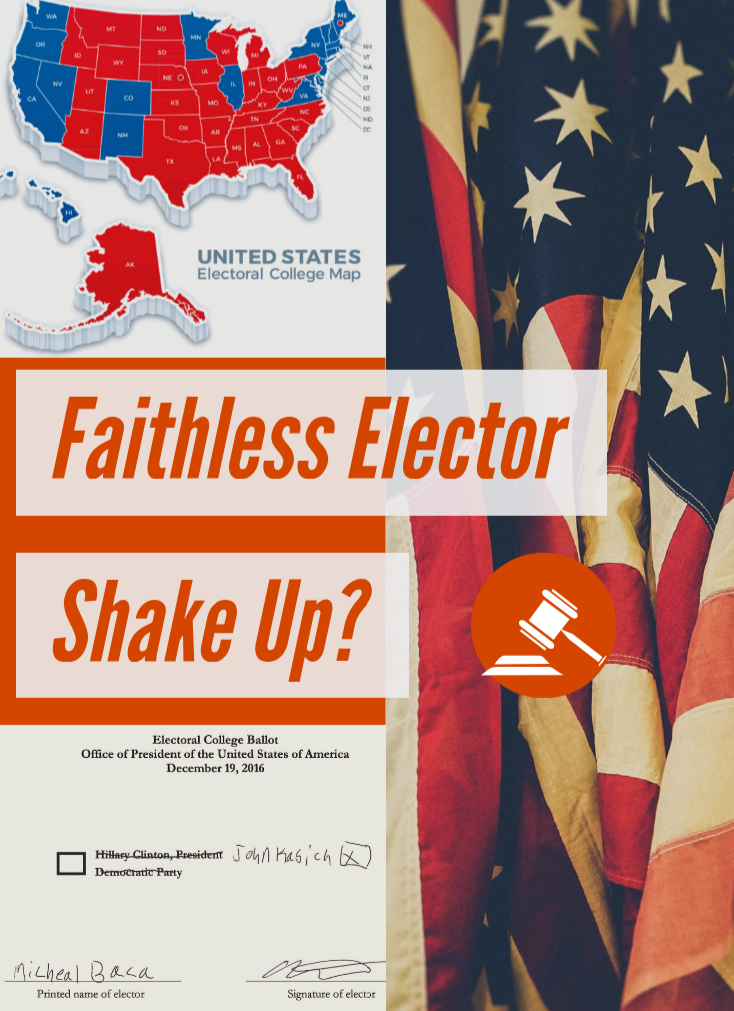On August 20, 2019, a divided panel of the United States Court of Appeals for the Tenth Circuit held that state presidential electors have a Constitutional right to vote for the candidates of their choosing for the offices of President and Vice-President. This decision is the first to create such a precedent, and it raises uncertainty about the Electoral College ahead of the 2020 Presidential election.
The Electoral College
Article II and the Twelfth Amendment of the Constitution set out the procedure for electing the country’s President and Vice-President. Article II provides that “Each State shall appoint, in such Manner as the Legislature thereof may direct, a Number of Electors” equal to the total number of Senators and Representatives to which the state is entitled. These appointed electors later “vote by Ballot” for the President and Vice-President. For each office, the candidate with the greatest number of votes wins. While each state legislature can specify the manner by which it will appoint presidential electors, many states also have a longstanding practice of requiring the electors to vote according to the popular vote of that state.
The Backstory
The case before the Tenth Circuit, Baca v. Colorado Department of State, arose out of the 2016 Presidential election. Michael Baca was appointed as one of Colorado’s nine presidential electors. Colorado law requires the state’s electors to vote for the Presidential and Vice-Presidential candidates who win the popular vote in the state. In 2016, Hillary Clinton and Tim Kaine won the Colorado popular vote, meaning that Colorado law obligated Mr. Baca to cast his vote for these candidates.
Despite taking an oath to vote in accordance with the state’s general election results, Mr. Baca cast his vote for John Kasich instead of Hillary Clinton. The Colorado Secretary of State subsequently removed him as an elector, did not count his vote, and appointed a substitute elector to vote for Hillary Clinton. Two other electors who had also planned to vote for John Kasich voted for Hillary Clinton after they witnessed Mr. Baca’s removal as elector.
Mr. Baca and the two other electors sued under 42 U.S.C. § 1983, arguing that the Colorado Department of State violated their Constitutional rights. The district court dismissed the claims, concluding that the Colorado statute merely codified the “historical understanding and longstanding practice” of requiring state electors to adhere to the state’s popular vote. On appeal, the plaintiffs argued that Article II and the Twelfth Amendment of the Constitution give state electors the right to exercise independence and discretion in casting their votes.
The Tenth Circuit’s Decision
In a lengthy opinion, the Tenth Circuit first resolved questions of standing and mootness. The Court held that, of the three plaintiffs, only Mr. Baca had standing to sue, and only to the extent he sought retrospective relief. The only retrospective relief Mr. Baca sought was a finding that his federally protected rights were violated. Next, the Court determined that the claim was not moot and could proceed.
The Court framed its analysis of the substantive arguments by asking whether the Constitution expressly permits a state to remove or bind an elector, not whether there is some Constitutional bar to taking those actions. It first determined that a state’s power to “appoint” electors is plenary. However, according to the Court, presidential electors perform a federal function when casting a vote, not a state function. The power to appoint therefore does not encompass the power to remove an elector.
The Court also pointed out that once a state has appointed its electors, the Constitution provides no further role for the state. The state therefore cannot “interfere” with the electors’ performance of their federal function. In addition, the Court found that the Constitution’s use of words such as “elector,” “vote,” and “ballot” indicated that electors have discretion when carrying out their duties.
Finally, the Court considered historical practices. Even though there has been a longstanding practice of having electors pledge themselves to vote in accordance with the results of a state’s popular vote, the Court reasoned that such a practice could not overcome the Constitution itself. The Court also emphasized that since 1796 there have been some 167 “faithless” votes, all of which have been counted by Congress.
What Comes Next?
Although the Tenth Circuit remanded the case for further proceedings, the parties will likely seek Supreme Court review of the decision in advance of the 2020 Presidential election. The Supreme Court has not directly addressed this issue before. For those looking to reform or even do away with the Electoral College, this decision is a welcome one. Critics of the decision contend that the Court relied too heavily on the text of the Constitution at the expense of broader democratic principles and that the decision could result in “chaos.” Potential Supreme Court review is something to keep an eye on, as are state efforts to circumvent the Electoral College more broadly, such as by passing laws to award the state’s electoral votes to the winner of the national popular vote.
Sources
Baca v. Colo. Dep’t of State, No. 18-1173, 2019 U.S. App. LEXIS 24805 (10th Cir. Aug. 20, 2019).
Colo. Rev. Stat. § 1-4-304(5).
Debra Cassens Weiss, “Faithless Electors” Have Right to Vote for Presidential Candidates of Their Choice, 10th Circuit Says, ABA J. (Aug. 22, 2019).
FairVote, Faithless Electors (last visited Aug. 29, 2019).
Meagan Flynn, He Tried to Stop Trump in the Electoral College. A Court Says His “Faithless” Ballot Was Legal, Wash. Post (Aug. 22, 2019).
Noah Feldman, Appeals Court Opens the Door to Electoral College Chaos, Bloomberg (Aug. 25, 2019).
U.S. Const. art. II, § 1, amended by U.S. Const. amend. XII.

